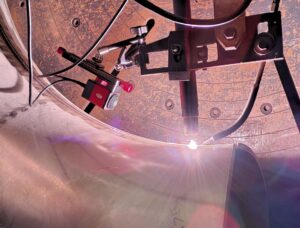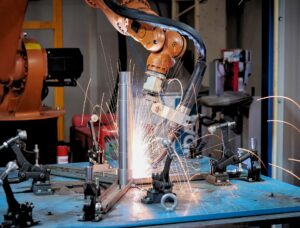In this blog, we’ll provide The Complete Guide to Weld Pool Monitoring, examining how real-time analysis of welding dynamics is revolutionizing quality control across manufacturing industries. Weld pool monitoring represents the cutting edge of welding quality control, providing unprecedented insight into the dynamic processes that determine final weld quality. By analyzing temperature distribution, fluid flow patterns, and penetration characteristics in real-time, manufacturers can achieve levels of quality control that were impossible with traditional methods.
Understanding Weld Pool Dynamics
The weld pool is a complex, dynamic system where multiple physical phenomena interact:
Heat Transfer: Conduction, convection, and radiation all contribute to temperature distribution within the weld pool and surrounding base metal.
Fluid Flow: Molten metal circulation driven by electromagnetic forces, surface tension gradients, and buoyancy effects.
Phase Changes: Continuous melting and solidification as the heat source moves along the joint.
Chemical Reactions: Oxidation, alloying, and gas evolution that affect weld pool composition and behavior.
Understanding these interactions is essential for effective monitoring and control.
Temperature Monitoring Technologies
Advanced temperature monitoring employs several sophisticated approaches:
Multi-Spectral Pyrometry: Measurement of thermal radiation at multiple wavelengths to determine true temperature despite surface emissivity variations.
Thermal Imaging: High-resolution infrared cameras that map temperature distribution across the entire pool and heat-affected zone.
Embedded Sensors: Thermocouples and resistance temperature detectors placed strategically to monitor specific locations.
Laser-Based Thermometry: Non-contact measurement using laser-induced fluorescence or other optical techniques.
Critical Temperature Parameters
Effective temperature monitoring focuses on several key parameters:
Peak Temperature: Maximum temperature reached in the weld pool, which affects penetration depth and microstructure.
Temperature Gradient: Rate of temperature change across the pool, which influences solidification patterns and residual stress.
Cooling Rate: Speed of temperature decrease, which determines final microstructure and mechanical properties.
Thermal Cycle: Complete heating and cooling history that affects heat-affected zone properties.
Fluid Flow Analysis
Weld pool fluid flow significantly impacts final weld quality through its effects on:
Mixing: Circulation patterns determine how filler metal and base metal are mixed, affecting chemical composition uniformity.
Inclusion Transport: Flow patterns influence how oxides and other inclusions are distributed or removed from the weld.
Heat Distribution: Convective heat transfer within the pool affects temperature uniformity and penetration patterns.
Surface Profile: Flow patterns determine the final weld bead shape and surface characteristics.
Monitoring Fluid Flow Patterns
Several techniques enable real-time fluid flow monitoring:
Particle Image Velocimetry (PIV): Tracking of small particles or surface features to map flow velocities across the pool surface.
Thermal Flow Mapping: Using temperature variations to infer flow patterns within the molten pool.
High-Speed Imaging: Ultra-high-speed cameras that capture flow phenomena occurring in milliseconds.
Computational Flow Modeling: Real-time simulation models that predict flow patterns based on measured parameters.
Penetration Analysis Techniques
Penetration monitoring is critical for ensuring adequate joint strength:
Keyhole Monitoring: Direct observation of keyhole formation, stability, and collapse in deep penetration welding.
Backside Monitoring: Cameras or sensors positioned behind the joint to detect full penetration.
Ultrasonic Monitoring: Real-time ultrasonic measurement of weld penetration depth.
X-Ray Imaging: Real-time radiographic imaging for critical applications requiring complete penetration verification
Integrated Monitoring Systems
Modern weld pool monitoring integrates multiple technologies:
Multi-Sensor Fusion: Combination of thermal, optical, and acoustic sensors for comprehensive pool analysis.
Synchronized Data Acquisition: High-speed, synchronized capture of multiple data streams for correlation analysis.
Real-Time Processing: Edge computing systems that analyze data instantaneously and provide immediate feedback.
Machine Learning Integration: AI algorithms that learn normal pool behavior and identify anomalies indicating potential defects.
Process Control Applications
Weld pool monitoring enables sophisticated process control:
Adaptive Parameter Control: Automatic adjustment of welding parameters based on real-time pool analysis.
Penetration Control: Closed-loop control of heat input to maintain consistent penetration depth.
Profile Control: Real-time adjustment of travel speed and weave patterns to achieve desired bead geometry.
Defect Prevention: Early detection of conditions that lead to weld defects, with automatic corrective actions.
Industry-Specific Applications
Different industries require tailored approaches to weld pool monitoring:
Aerospace: Ultra-precise monitoring of exotic materials with focus on complete penetration and defect-free welds.
Nuclear: Comprehensive documentation and monitoring for safety-critical applications with long service lives.
Automotive: High-speed monitoring for production welding with emphasis on consistency and cycle time optimization.
Pipeline: Monitoring of root pass penetration and cap pass profile for long-distance transmission systems.
Data Analysis and Interpretation
Effective weld pool monitoring requires sophisticated data analysis:
Pattern Recognition: Identification of normal and abnormal pool behavior patterns through statistical analysis.
Correlation Analysis: Understanding relationships between pool parameters and final weld quality.
Predictive Modeling: Development of models that predict final weld properties based on real-time pool data.
Quality Classification: Automatic classification of welds as acceptable or requiring further inspection.
Advanced Monitoring Algorithms
Modern systems employ sophisticated algorithms:
Kalman Filtering: Optimal estimation of pool parameters from noisy sensor data.
Neural Networks: Machine learning models that recognize complex patterns in pool behavior.
Fuzzy Logic: Control systems that handle uncertainty and imprecise measurements.
Wavelet Analysis: Time-frequency analysis of dynamic pool phenomena.
Calibration and Validation
Accurate monitoring requires proper system calibration:
Temperature Calibration: Regular calibration against known temperature standards.
Spatial Calibration: Precise geometric calibration of imaging systems.
Temporal Calibration: Synchronization of multiple data streams.
Validation Testing: Regular validation against destructive testing results.
Implementation Challenges and Solutions
Common implementation challenges include:
Environmental Interference: Electromagnetic noise, vibration, and contamination that affect sensor performance.
Access Limitations: Restricted physical access to the weld pool in some applications.
Data Volume: Managing and processing large volumes of high-speed data.
Integration Complexity: Integrating monitoring systems with existing welding equipment and processes.
ROI Considerations
The return on investment for weld pool monitoring includes:
Quality Improvements: Reduced defect rates and improved weld consistency.
Process Optimization: Identification of optimal welding parameters for different applications.
Predictive Maintenance: Early detection of equipment problems before they affect quality.
Documentation: Complete process documentation for quality assurance and traceability.
Future Developments
Emerging technologies in weld pool monitoring include:
Quantum Sensors: Ultra-sensitive sensors for measuring minute variations in pool properties.
AI Integration: Advanced artificial intelligence for real-time decision making and process optimization.
Digital Twin Technology: Virtual models that predict pool behavior and optimize welding parameters.
Augmented Reality: Real-time overlay of monitoring data onto the operator’s view of the welding process.
Best Practices for Implementation
- Clear Objectives: Define specific quality and productivity goals for the monitoring system.
- Proper Training: Comprehensive training for operators and maintenance personnel.
- System Integration: Careful integration with existing welding equipment and quality systems.
- Continuous Improvement: Regular analysis of monitoring data to optimize system performance.
- Vendor Support: Strong relationships with technology suppliers for ongoing support and updates.
Conclusion
Weld pool monitoring represents a fundamental shift in welding quality control, moving from post-process inspection to real-time process control. The ability to monitor temperature, flow, and penetration in real-time enables unprecedented levels of quality assurance and process optimization.
As these technologies continue to mature and costs decrease, weld pool monitoring will become standard practice across industries where welding quality is critical. Manufacturers who embrace these technologies today will have significant competitive advantages in terms of quality, efficiency, and customer satisfaction.
Need help choosing the best welding camera for welding applications? Mecaweld offers tailored solutions for every industry—from fabrication to aerospace. Contact us today to learn more.



